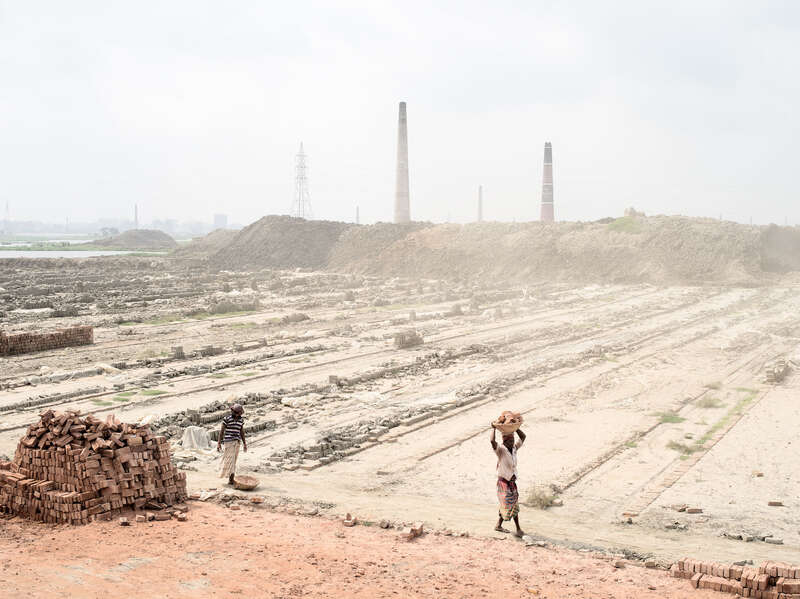
Seasonal workers carrying fired bricks, Gabtoli, Dhaka, Future Scenarios (2016-2020)
Decolonizing the Future
Part II: Reflections on Artistic Collaboration, Interactive Citizenship and Indigenous Cosmologies
Editor’s note
In their two-part-contribution to Trigger, Dobrowolska and Ormond-Skeaping look back on the making of their multimedia project Future Scenarios (2016–2021). You can read part one here. Part two is an autoreflective conversation on documentary practice, interactive citizenship, image ecologies and their own positioning in Future Scenarios.
Lena Dobrowolska & Teo Ormond-Skeaping
12 mrt. 2021 • 19 min
Extractivism in Photography
Teo: Although in the past, both of us have speculated about what we might’ve achieved if we were scientists or doctors, human rights lawyers or policymakers, we’re now perhaps too far down the rabbit hole of being artists, documentarians and filmmakers to change tracks. Yet, the underlying drive to “do good” compelled us to ask: what if I had studied medicine? Could I have been more useful? This remains a driving force to address difficult and complicated issues, but perhaps more importantly, we now also recognise it as a force to be reckoned with.
Like many documentarians, we’ve at times realised that we’ve failed to be auto-critical. When “doing good” was later recognised as not doing so good, it was often far too late to correct the mistakes we’d made. Our long-term project, Future Scenarios, is no exception and suffers from numerous critical flaws and regrettable mistakes.
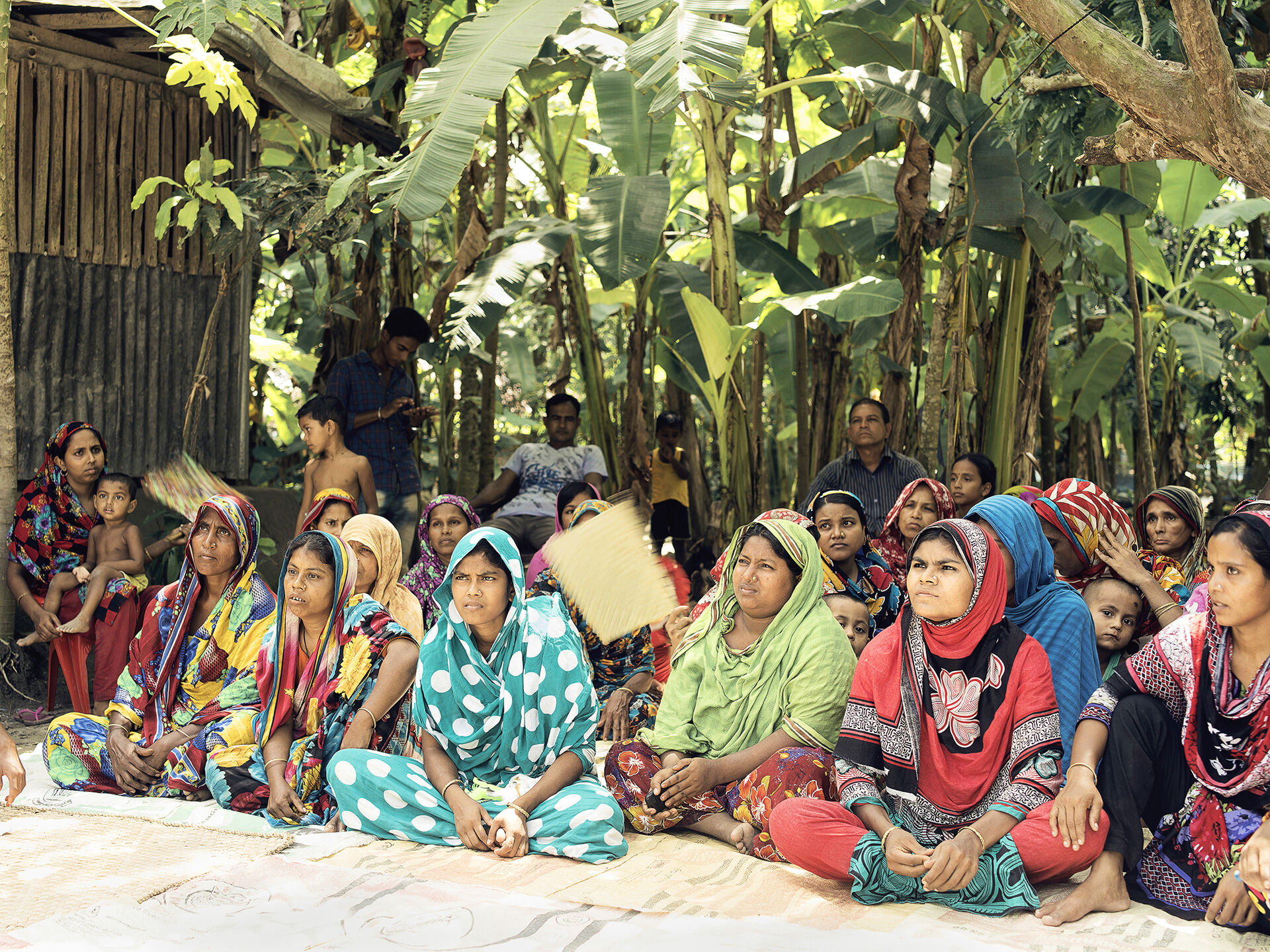
Cyclone disaster preparedness courtyard meeting, Dalbanga South, Barguna, Bangladesh, Future Scenarios (2016-2020)
Lena: Yes, unfortunately, the scenario thinking approach that we adopted when working on Future Scenarios could be considered somewhat problematic because it relied on appropriating the lived experiences of the people most vulnerable to climate change and reframing these experiences as possible future events. In so doing, we risked compounding the vulnerability and victimhood of the people we photographed and filmed by projecting sometimes pessimistic future scenarios onto them. We also struggled to include many of the people we photographed in the process of scenario thinking, even though we collaborated with senior community members and local researchers who had concerns and intentions and undertook work that aligned with our own project intentions. For example, senior community members and local researchers in Dalbanga South in Bangladesh, had concerns about the community’s vulnerability to storm surge and water stress, and intensions such as community wide disaster risk reduction and access to safe drinking water, which they actively worked to change through such things as cyclone preparedness meetings and the drilling of new bore holes, all of which related to our projects central questions of how is climate change affect vulnerable communities and what can we learn from them about how to deal with it.
Although we were able to collaborate meaningfully with researchers, policymakers and community leaders from the Global South at the national level, for example, with policymakers like Professor Saleemul Huq of the International Centre for Climate Change and Development, who was instrumental in shaping the project by steering it towards a focus on what can be learnt about climate change from those who are most vulnerable to it. As well as at the community level, for example with Moses, chairman of The Refugee Welfare Council of Cluster 2 at Bidi Bidi Refugee Settlement in Yumbe, Uganda, who, with the help of the council, guided us on what was relevant to their future and whom we should speak to before accompanying us to meet and photograph community members.
I think, in hindsight, we didn’t create enough opportunities for the people we photographed and filmed within communities to speculate about their own futures, nor did we underscore how their political agency was projected into the speculative futures we were constructing, which we could’ve.

Lone palm next to a failing coastal defence, Daulatkhan, Bhola Island, Bangladesh, Future Scenarios (2016-2020)
Teo: Regrettably so, and we didn’t find a way for our photography and filmmaking to be consistently co-directed or truly co-authored by everyone we interacted with, even though we spent a lot of time in each location. As a result, there’s the palpable presence of an asymmetric power dynamic in the imagery we’ve created, and because of this, our imagery could easily be read as othering or orientalist or as a superficial assessment and predetermination of the problems that the people we were documenting face, when the projects photographs and film footage are not contextualised within the research that underpins them.This auto-critique doesn’t relate to issues around consent, as we always worked with the full consent of communities and their members. Our photographs have been presented with extensive captions and place-based titles that often get lost as they enter the image economy, for example when they’re submitted to photographic competitions or reposted on Instagram and even, to our surprise, when presented in exhibitions for which we don’t directly control the installation of the works.
Lena: I agree. In many ways, we might consider that we only managed to document the power dynamics between us as photographers, filmmakers and citizens from the climate-responsible Global North and those adversely affected by climate change in the Global South, whom we subjected to being photographed and filmed.
Teo: Yes, that’s true. The only thing we can say for sure is that the power dynamic in the imagery of Future Scenarios is accurately representative of the Global North–Global South geopolitical power and wealth divides and the Global North–Global South climate responsibility and vulnerability divides.
Lena: Exactly, and this is problematic because, arguably, it means that the project leans more towards being extractive than not.
Teo: But do you think photography and filmmaking can ever operate in a way that’s not extractive? Does an overzealous focus on the ethics of representation its self, or the who has the right to represent who question reduce our capacity as storytellers with limited resources, to address structural inequalities, racism and violence? Or is it an essential part of that enquiry? One that ensures that photographers and filmmakers don’t perpetuate the same violence on those that they’re trying to help?
Lena: The latter, we should be concentrating hard on making representations that align with current critical thinking around structural inequality. One simply can’t be separated from the other. Representation should be the product of a critical engagement with the structure in which the imagery is created. Otherwise, we risk creating visual tropes that perpetuate power dynamics that create the inequality we’re trying to eliminate. However, documentary photographers and filmmakers will continue to face an uphill battel to address the power structures of image production with their work if the gate keepers, those who commission, curate, programme, publish and edit documentary photography and film aren’t also addressing the same issues in relation to their own institutions and practices.
Teo: What you’re saying is that we should strongly focus on further enhancing the collaborative, participatory and reflective aspects of whatever collaborative scenario thinking methodology we may deploy in the future to assure that the intentions of all of those who participate in its making, whether in front of the camera or behind and at every stage of production, are aligned. This is the only way we can guard against extractive documentary practices.
Lena: In a nutshell, that’s it. Recently, I’ve been thinking about how to better deploy collaborative participatory strategies and decolonised modes of scenario thinking. I think multispecies feminist theorist Donna Haraway lends us some useful tools and ideas that we can work with as we try to achieve this goal through her practice of speculative fabulation, which is centred around developing solidarity, companionship and the creation of unexpected collaborations as ‘Oddkin’. On reflection, for me, the type of work we’re pursuing has become much less about a grand reconciliation of the Global North and South divide and more about finding small ways of ‘staying with the trouble’, a phrase used by Haraway to describe pursuing small acts of solidarity with one’s collaborators across the great divides of agency and privilege that help us imagine ourselves as participants in collective world making.Donna J. Haraway, Staying with the Trouble: Making Kin in the Chthulucene, (North Carolina: Duke University Press, 2016), 4. But where else have we found inspiration and examples of work that’s undertaken differently?
Teo: Perhaps unsurprisingly, we’ve found them in the Global South in the form of participatory filmmaking methodologies and indigenous media strategies. For example, we’ve been inspired by the participatory filmmaking strategy used in Nadine Labaki's 2018 film Capernaum
and the work of Indigenous media producers like the Latin American Council on Indigenous People’s Film and Video and the Rojava Film Commune established by Kurdish filmmaker Sevinaz Evdike. But we’ve also found inspiration and guidance in the work of a number of researchers and filmmakers from the Global North who’ve worked extensively in the Global South, including Joshua Oppenheimer, Renzo Martens and Ursula Biemann. The practices and research of all these groups and people are useful guides for helping us identify the virtues and shortcomings of different forms of participatory image-making, with the intention of developing our own participatory scenarios thinking methodology.
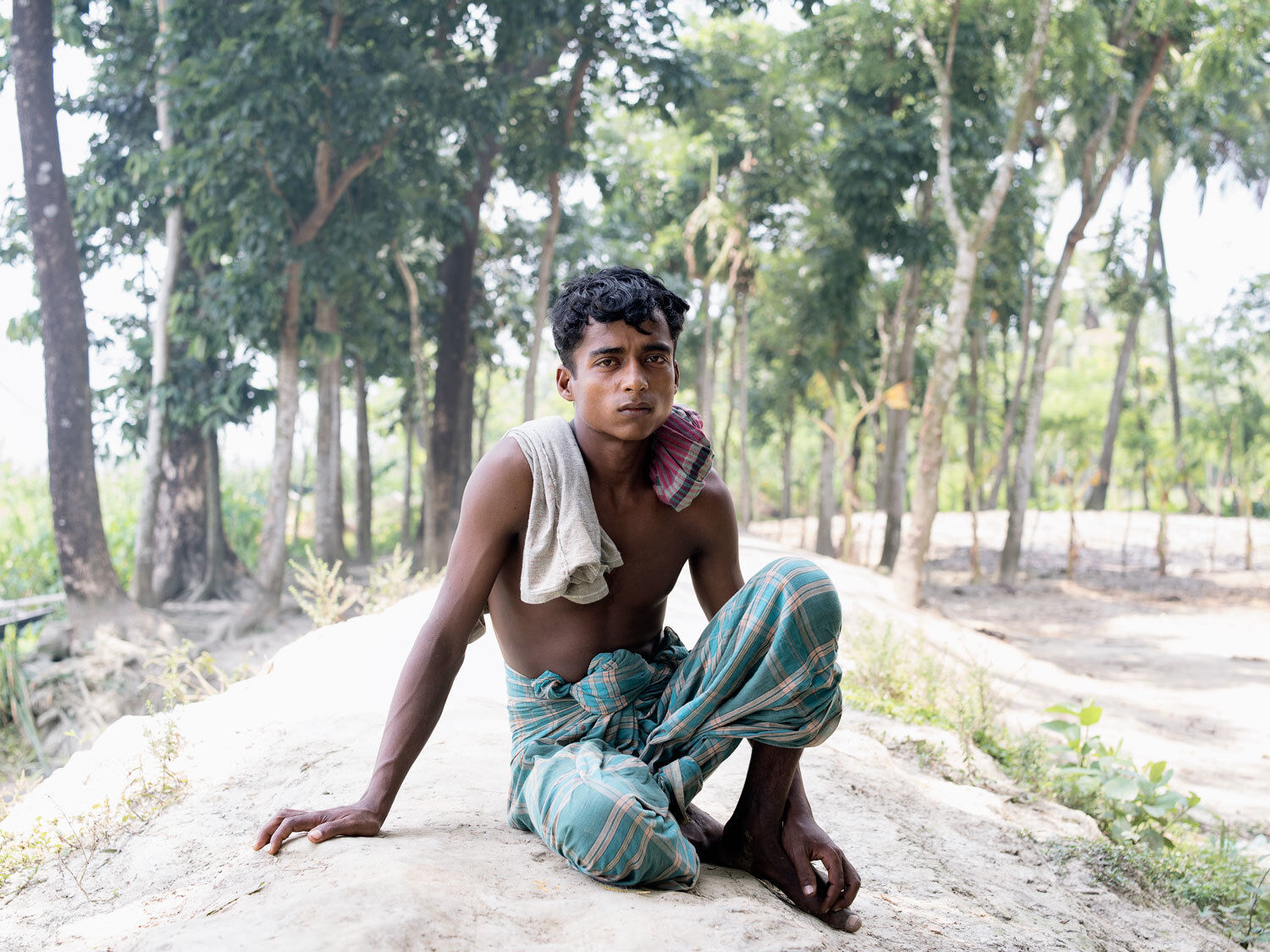
_______, on a flood bank, Dalbanga South, Barguna, Bangladesh, Future Scenarios (2016-2020)
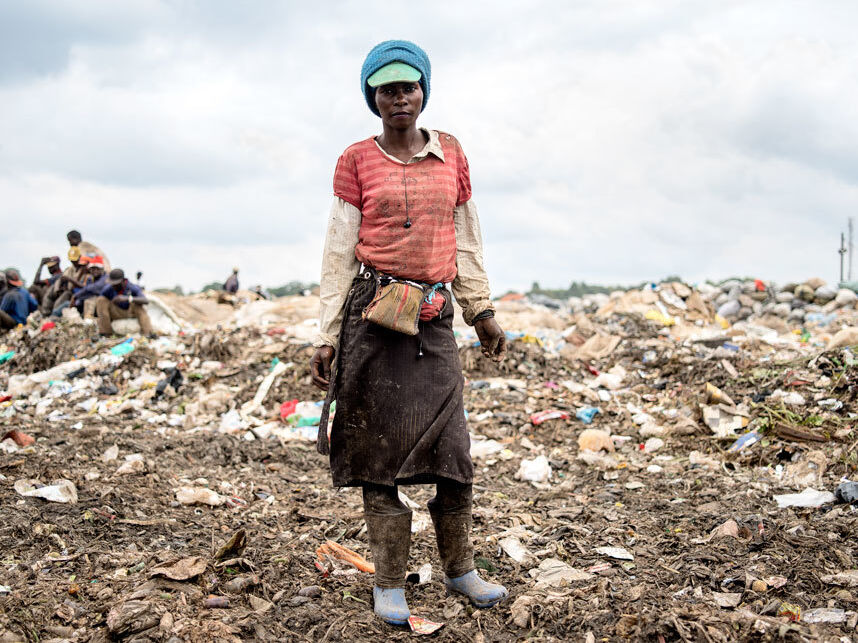
_______, Kiteezi municipal waste site, Kampala, Uganda, Future Scenarios (2016-2020)
Lena: In many ways, you were slower to take on board these critical reflections than I was. Why do you think that was? Was it related to you being a heterosexual White male from the United Kingdom?
Teo: Yes, I was. As we were starting the project, I still naively believed that pointing a camera at the problem was enough to draw attention to it. I thought that the representational toll of making such images would be outweighed by the change that I believed would come as a result of making and successfully disseminating them via the photography festival circuit, a photobook or a website or publication of the work. But, of course, that’s not the case, and I now know this. Images and films don’t change the world on their own if they’re not directly embedded in a specific policy agenda or utilised as evidence in a legal case. Without doing so, they may only, in some minute way, contribute to a paradigm shift that would enable a policy change, but that’s not guaranteed. Nor is it an adequate justification for shooting without considering the ethical implications of making representations of others in an extractive way.
I now know that an ethical and inclusive documentary practice is needed to ensure that practitioners aren’t creating dangerous representations that can perpetuate stereotypes or endanger individuals whose identities need protection. Such an approach is needed to ensure practitioners aren’t exhausting communities through extractive photographic or filmmaking practices that lead to research fatigue, which can make communities more wary of humanitarian, artistic or journalistic intervention. And most importantly, image makers shouldn’t cause direct harm to the individual or community they’re photographing or filming by exploiting them or their time. I can’t stress enough the importance of consent at the community and individual levels, which seems almost too elementary to bring up, but given recent reports that photographers from major photographic agencies have abused this basic ethical principle, it seems necessary.
Lena: It’s probably a good idea to mention it.
Allies or Accomplices?
Teo: Throughout the project, I’ve become increasingly critical of my past work and have focused on confronting my relationship to the United Kingdoms legacy of empire and my whiteness while moving beyond the trappings of the white saviour complex and heteronormative thinking that informed my decision to pursue becoming a photographer and filmmaker. When I first picked up a camera with serious intentions at eighteen, I was intent on becoming a war photographer because I wanted to change the world. Now, in retrospect, I can see how the heavily romanticized figure of the heroic conflict photographer, typically a heterosexual White male from the Global North, and the idea that photographs and film can change the world affected my younger self and, more importantly, the role that this notion plays in perpetuating the white saviour industrial complex over and above addressing the root causes of inequality, racism and violence. I think what’s shocking is how long it took to unlearn these things and how this reveals the inadequacy of photographic education in the English academic system. So, in the context of the United Kingdom, I don’t think it’s just a case of only needing to teach colonial history at the primary and secondary school levels but also the need to decolonise higher education, which is something that we are trying address in our teaching practices.
Lena: I don’t think this is your problem alone. I think it’s a wider systematic problem that’s built into our image ecology and the way in which images, particularly documentary images, are circulated in both the media landscape and the art world. Having not positioned our practice firmly in either camp, we’ve faced difficult decisions and painful losses of control over our images as we’ve learnt to navigate how, where and why we should be disseminating our work. Two particular examples stand out. The first, entering a photographic competition in the United Kingdom that was organised by a contemporary visual arts specialist that led one of our images to be featured and recaptioned in a right-wing tabloid in a way that orientalised the person in the portrait, even though we had insisted that the image be displayed with its original caption or not at all. The second, when we were told by a gallerist from a renowned gallery specialising in contemporary documentary photograph from the Middle East that they weren’t willing to represent a project that had been used by a university as a teaching aid or displayed online as an interactive documentary.
Teo: Yes. Competitions, career pressures and the goals and practitioners who I aspired to most definitely affected the way I made images, the way I thought about them and, therefore, how much headspace I dedicated to auto-criticism.
Lena: What do you hope to achieve by making this change in your practice and by understanding these things?
Teo: By decolonising my filmmaking and photographic practices, I hope that I can move towards something resembling what Renata Tyszczuk describe to us as ‘interactive citizenship’ and away from the commercial pressures and unethical qualities of the contemporary neoliberal art and photography worlds.We fully realise that the notion of citizenship is problematic in itself to some extend particularly when thinking about transnational public spheres, where the public of certain nation states are “ increasingly not citizens of that nation state (but are for example expats, labour migrants or people without documents)…we should therefore disengage the notion of the public from the traditional notion of citizenship (as in being born in a certain nation state) and see it as all those who are ‘affected’ by certain political issue ”. Philipp Dietachmair & Pascal Gielen, The Art of Civil Action: Political Space and Cultural Dissent, (Antennae-Art in Society Valiz, Amsterdam, 2017), 4. I also hope that by doing so, I can become better equipped to share knowledge, technical expertise and resources while collaborating with artists, scientists, researchers and people from Indigenous and minority communities.
Most importantly, I hope that by adopting the role of an artist as researcher, which we were encouraged to do during the Culture and Climate Change: Scenarios residency, I’ll be able to dispel the requirement to produce a so-called artwork when knowledge transfer alone should suffice. In so doing, I believe I’ll be better able to focus wholly on what can be learnt from those who are most vulnerable to and yet most knowledgeable about how to address things like climate change, colonisation and slow violence and be less worried about how to respond to this knowledge or work with it as an artist.
As a result of our 2019 journey to The United Nations Climate Change Conference in Madrid, where we had the opportunity to sit in on the informal negotiation of the Warsaw International Mechanism for Loss and Damage,‘Art in the Blue Zone’, Acclimatise, 13 January 2020, http://www.acclimatise.uk.com/2020/01/13/art-in-the-blue-zone/ I now see my research-based artistic practice moving towards a ‘policy specific artistic practice’A process/method first mentioned to us by a curator and a human rights lawyer Entwisle Chapuisat, who works with Displacement Uncertain Journeys. that targets policymakers while they’re engaged in the act of negotiating multilateral agreements. The aim of such a practice is to encourage policymakers and negotiators to address the remnants of empire that plague such institutions as the climate change conference itself, decolonizing developmental institutions and practices and to urge them to more quickly find radical and progressive ways of protecting the people who stand to be most affected by a warmer world.Arundhati Roy, ‘The pandemic is a portal’, Financial Times, 3 April 2020, https://www.ft.com/content/10d8f5e8-74eb-11ea-95fe-fcd274e920ca
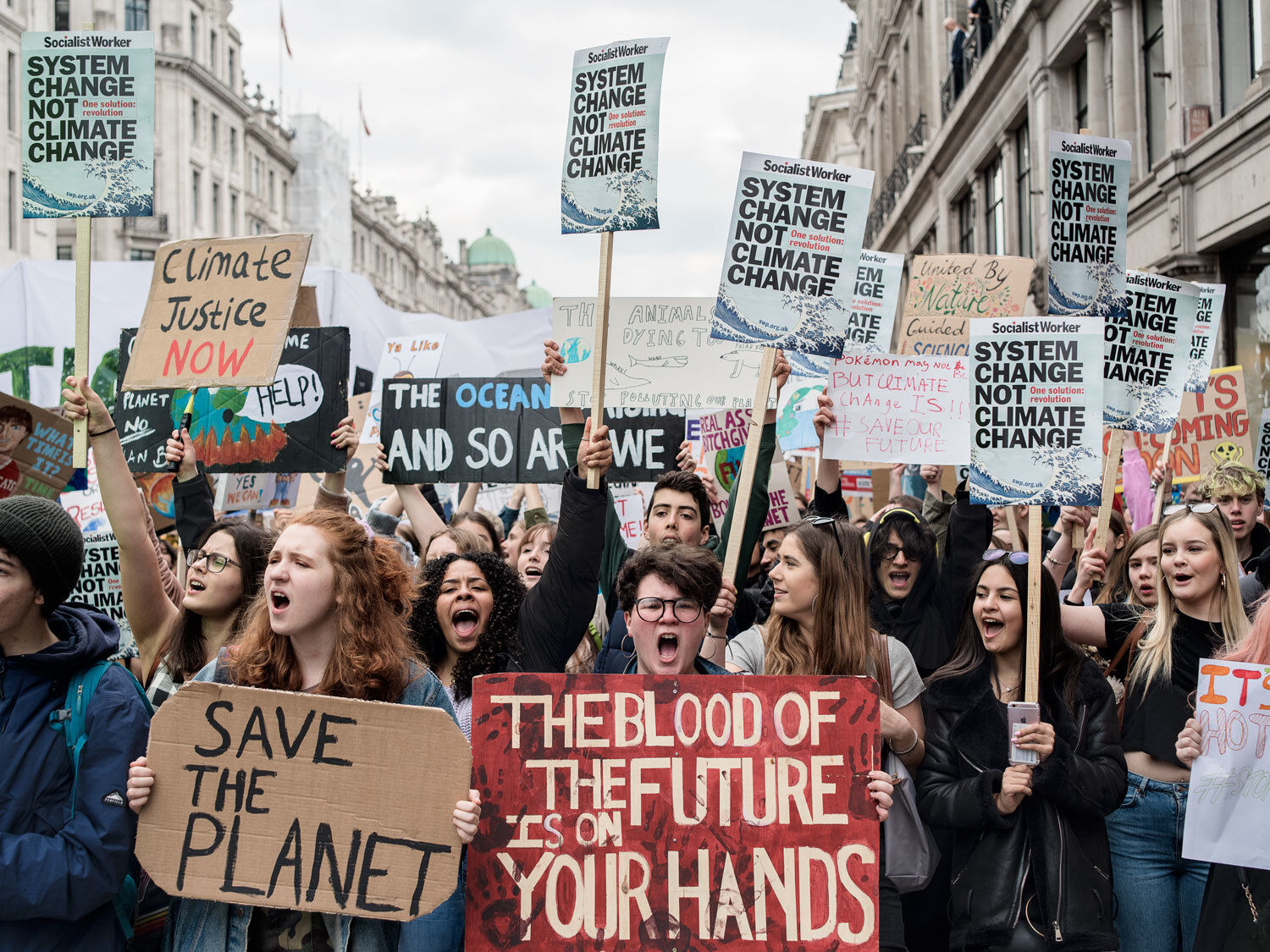
Fridays For Future School Strike Protest, Piccadilly Circus, London, UK, Future Scenarios (2016-2020)
Lena: In response to your journey, I suggest that you’ve transitioned from being an ally of the people you’re representing to an ‘accomplice’.Accomplices Not Allies: Abolishing the Ally Industrial Complex, The Indigenous Action, 4 May 2014, https://www.indigenousaction.org/accomplices-not-allies-abolishing-the-ally-industrial-complex/
Teo: Interesting. Can you unpack that a bit?
Lena: To explain, we could consider that during, for example, the Black Lives Matter of last summer and Standing Rock protests, allyship became somewhat problematic, as signals of superficial support, such as social media posts, were chosen over and above direct action, under the guise of raising awareness. In those cases, attention was drawn to the ally’s own ego or cause at the expense of the oppressed community. An accomplice, on the other hand, is someone who engages radically and directly to build more meaningful forms of solidarity with oppressed people.
Teo: You have a very different relationship to colonialism and whiteness than I do, don’t you? Which is why you were much more aware of the critical omissions that I was making when we were working on the project. That was something that actually caused us to have very strong and often irreparable disagreements while we were making it.
Lena: Yes. As a Polish citizen, my ethnicity is classified as ‘white other’ whenever I fill out a form in the United Kingdom. For me, the term accurately describes the division that can be drawn between first- and second-class Europeans or those that have colonised, like the United Kingdom or France, and those that have not, or in fact, have been colonised by others, like Poland. It also recognises the otherness that was used to spotlight Eastern European migrants by Vote Leave during the Brexit campaign and the etymology of the world ‘slave’, which comes from ‘slav’ and a point in history when the Slavic people of Eastern Europe were enslaved in Europe and in the Middle East. It also reminds me of more recent moments in history, such as the partition of Poland in the eighteenth century or the colonial mechanisms of ethnic cleansing during World War II. As a result, I am much more keenly aware of those mechanisms and the pain of being othered. However, that’s not to say that I don’t benefit from white privilege because of the colour of my skin.Julia Octavia Halej, ‘Other Whites, White Others: East European Migrants and the Boundaries of Whiteness’, thesis, (University College London, 2014).
That’s why I’ve long struggled with applying the notion of allyship to our work and the fact that we’re often tasked by many of those that we work with or are funded by to raise awareness. It troubles me because I intend my practice to be centred around more responsible approaches, and I’d hoped, and still do, that artists would be given mandates by the states, organisations or funders that support them to directly use their artistic practices to bring about changes that align with the work and intentions of the communities they depict and the policymakers who serve them. That’s my big dream. I therefore continue to work towards becoming a more radically engaged filmmaker, photographer, practitioner, educator and researcher.
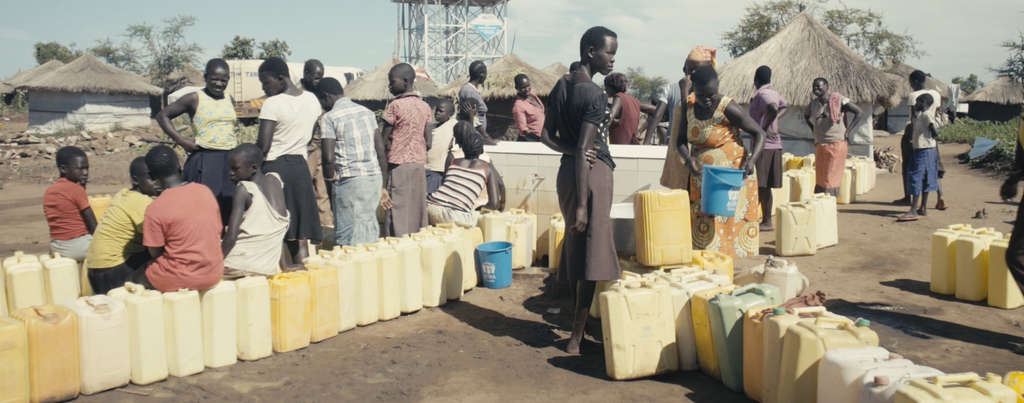
Film still, Three-channel installation, Future Scenarios (2016-2020).
Influencing Policymakers
Teo: With all that in mind, what’re we doing about it? How are we implementing these changes in our new and ongoing projects?
Lena: Recently, we’ve deployed a participatory and collaborative scenario making methodology while working on our new narrative film project: You Never Know: One Day You Too Could Be a Refugee, which we’re developing with Displacement Uncertain Journeys and The Platform on Disaster Displacement for policymakers and negotiators inside the Blue Zone at the November 2021 United Nations Framework Convention on Climate Change Conference in Glasgow.‘When Art meets Politics: Art, Climate, Disaster and Displacement at COP25’, Platform on Disaster Displacement, 9 December 2019, https://disasterdisplacement.o...
The film, which will include several parallel narratives, will tell the story of a white middle-class family displaced from a future England. They have to migrate to an unknown nation in the Global South in an unknown future, where they’re generously hosted. At the same time, in parallel, the film will also show the family’s asylum interview and the negotiation of an ambitious climate and migration policy under something like the Warsaw International Mechanism for Loss and Damage at a fictitious United Nations Climate Change Conference.
Although, as we develop the script, we’re going to draw on the lived experiences of the refugees and climate migrants we met in Bangladesh and Uganda and refugee testimonies documented by researchers and relief agencies and focused on climate-induced displacement. We’re also going to reflect on my lived experience of migrating to the United Kingdom and collaborating with a group of advisers from the Platform On Disaster Displacement’s advisory board, which is made up of a broad spectrum of climate and migration experts in the fields of policymaking, law, disaster displacement, and culture, some of whom are themselves former refugees from both the Global North and South. Together, we’ve undertaken collaborative scenario making exercises to develop script ideas that speak directly to policymakers working at United Nations Climate Change Conference in Glasgow to further policy objectives and protect people at risk of experiencing climate-induced displacement.
We’ll also be working with amateur actors (activists, policymakers and researchers) and assistant directors from climate-vulnerable nations to create a space for improvising a debate akin to a climate conference negotiation session; the debate will focus on what a just climate and migration policy entails and how it may be opposed by nations in the Global North as a result of their blind spots. All of this is intended to directly relate to the lived experiences of policymakers themselves at the United Nations Climate Change Conference in Glasgow.
Teo: What we’ve learnt so far is that we’ll be recasting the migrant narrative with white middle class protagonists and working with speculative and hybrid geography to turn a post Brexit un-United Kingdom into a severely climate-vulnerable nation that experiences massive climate-induced displacement events. We’re also working with a speculative scenario in which the Global North–South power dynamic and the direction of migratory flow are inverted. By queering the migrant image, the direction of migratory flow, the world’s geopolitical power dynamic and the United Kingdom’s geography in this way, we wish to create a narrative vehicle we can use to critically address the power structures that contribute to the politicisation of support for and tolerance of displaced persons, delayed climate action and the undermining of the capabilities of southern nations to adequately prepare for the climate mutation.
In this way, we hope to challenge policymakers to envision habitable and just climate futures and to encourage them to push back against future scenarios that favour the ‘politics of the armed lifeboat’ that would see the world divided into fortress states or blocks.Christian Parenti, Tropics of Chaos (New York City: Hachette, 2011). Ultimately, we hope to see policymakers from the Global North adopt self-aware and critical stances that engender a more radical and compassionate outlook, one that leads them to prioritise future scenarios of collective survival that are inclusive and just and that will remain habitable for generations to come.